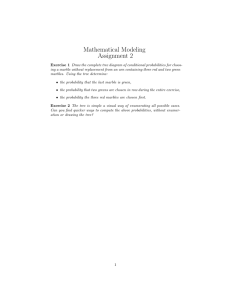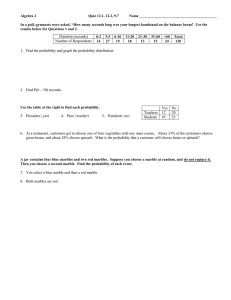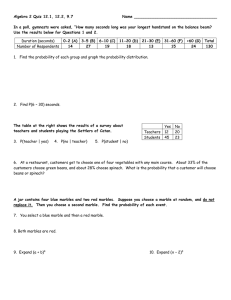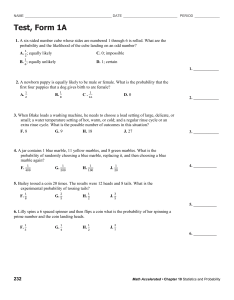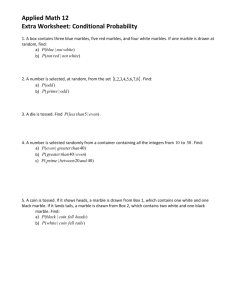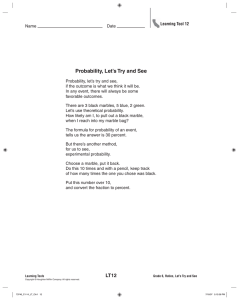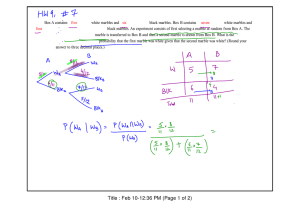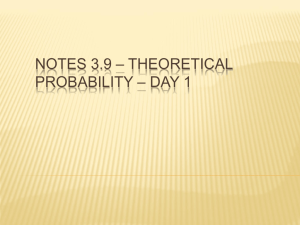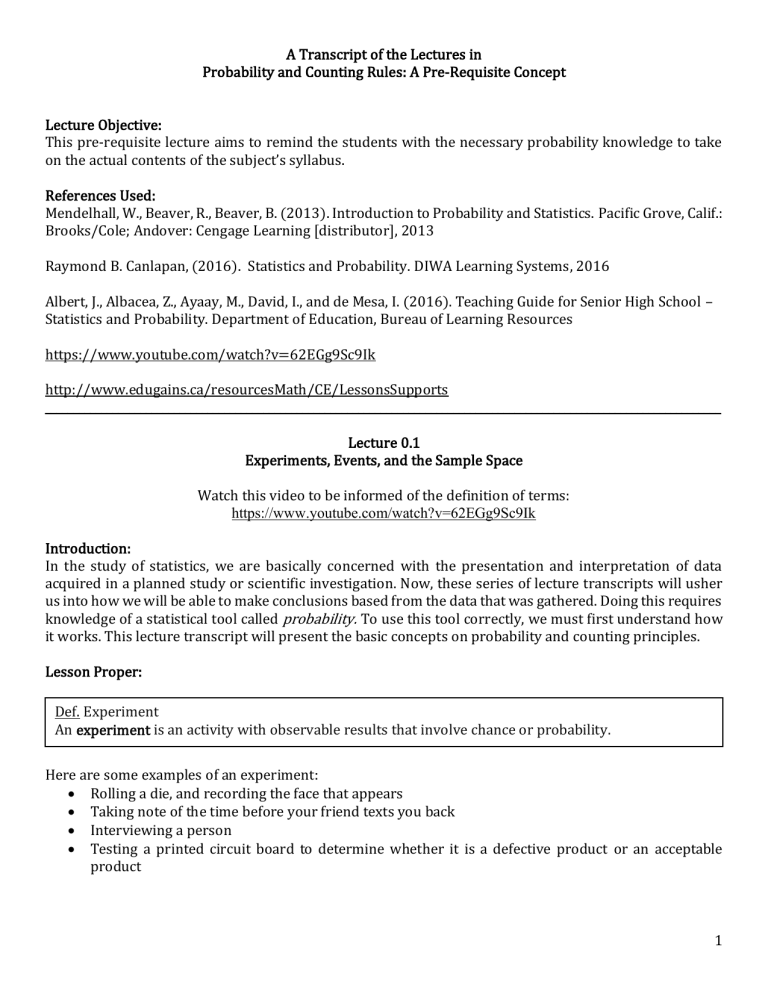
A Transcript of the Lectures in
Probability and Counting Rules: A Pre-Requisite Concept
Lecture Objective:
This pre-requisite lecture aims to remind the students with the necessary probability knowledge to take
on the actual contents of the subject’s syllabus.
References Used:
Mendelhall, W., Beaver, R., Beaver, B. (2013). Introduction to Probability and Statistics. Pacific Grove, Calif.:
Brooks/Cole; Andover: Cengage Learning [distributor], 2013
Raymond B. Canlapan, (2016). Statistics and Probability. DIWA Learning Systems, 2016
Albert, J., Albacea, Z., Ayaay, M., David, I., and de Mesa, I. (2016). Teaching Guide for Senior High School –
Statistics and Probability. Department of Education, Bureau of Learning Resources
https://www.youtube.com/watch?v=62EGg9Sc9Ik
http://www.edugains.ca/resourcesMath/CE/LessonsSupports
_________________________________________________________________________________________________________________________
Lecture 0.1
Experiments, Events, and the Sample Space
Watch this video to be informed of the definition of terms:
https://www.youtube.com/watch?v=62EGg9Sc9Ik
Introduction:
In the study of statistics, we are basically concerned with the presentation and interpretation of data
acquired in a planned study or scientific investigation. Now, these series of lecture transcripts will usher
us into how we will be able to make conclusions based from the data that was gathered. Doing this requires
knowledge of a statistical tool called probability. To use this tool correctly, we must first understand how
it works. This lecture transcript will present the basic concepts on probability and counting principles.
Lesson Proper:
Def. Experiment
An experiment is an activity with observable results that involve chance or probability.
Here are some examples of an experiment:
• Rolling a die, and recording the face that appears
• Taking note of the time before your friend texts you back
• Interviewing a person
• Testing a printed circuit board to determine whether it is a defective product or an acceptable
product
1
Def. Outcomes
The outcomes of an experiment are the results of experiment.
Given this definition, the possible outcomes of the experiment, “Rolling a die, and recording the face that
appears” then are:
• Observing a one (1)
• Observing a four (4)
• Observing a two (2)
• Observing a five (5)
• Observing a three (3)
• Observing a six (6)
Def. Sample Space
The sample space is the set of all possible outcomes of an experiment.
Using the previous example, the sample space is expressed as 𝑆 = {1,2,3,4,5,6}.
Remark. The terms “outcomes” and “sample space” are used almost often interchangeably. By convention,
sample spaces are expressed using the set-builder notation. Further, note that as we go along the lectures,
we will frequently determine the total number of outcomes of an experiment (or equivalently, total number
of the sample space). To this, it is important to take note of the notation that is used for the total number
of outcomes:
In the previous experiment, the total number of outcomes of the sample space 𝑆, or in notation, 𝑛(𝑆), is
equal to 6.
Def. Sample Point
A sample point is one of the possible outcomes of an event. Similar to sample spaces, sample points
are expressed in set-builder notation as well.
A sample point then of the experiment “Rolling a die, and recording the upper face that appears” could be
{1}, or {2}, or {3}, or {4}, and so on...
Def. Event
An event is defined as one or more outcomes of an experiment. In other words, an event is a subset of
the sample space
Take for example the following statement:
“A spinner wheel has 4 equal sectors colored brown, pink, gray and orange. What are the chances of
landing on gray after spinning the spinner?”
Note that the experiment is clearly spinning the spinner wheel, while the event is landing on the color gray.
Remark. By convention, an event is denoted with a capital letter E (or other capital letters unless
otherwise stated).
2
Example 0.1.1. Given the situation “Carlo wants to see how many times a ‘double’ comes
up when throwing a pair of dice”, determine the experiment, event, sample space,
sample points, number of outcomes of the event, and the total number of outcomes of
the sample space.
Solution to Example 0.1.1
Clearly, the experiment is throwing a pair of dice. On the other hand, the event is the act in which Carlo was
looking for a double (where both dice have the same number), and this can also be expressed as 𝐸 =
{(1,1), (2,2), (3,3), (4,4), (5,5), (6,6)}. Meanwhile, the sample points could be any of the following: {(1,1)},
{(2,2)} , {(3,3)}, {(4,4)}, {(5,5)}, or {(6,6)}. Given this, we see that 𝑛(𝐸) = 𝑛(a double comes up) = 6, while
𝑛(𝑆) = 𝑛(possible outcomes of tossing a pair of die) = 36.
Remark. Note that the result of 𝑛(𝑆) might not be intuitive at first. So, to help us visualize the result, a
tabular strategy of listing the possible outcomes may be employed:
Outcomes
of Rolling
Die 1
1
2
3
4
5
6
Outcomes of Rolling Die 2
1
2
3
4
5
6
1, 1
2,1
3, 1
4, 1
5, 1
6, 1
1, 2
2, 2
3, 2
4, 2
5, 2
6, 2
1, 3
2, 3
3, 3
4, 3
5, 3
6, 3
1, 4
2, 4
3, 4
4, 4
5, 4
6, 4
1, 5
3, 5
3, 5
4, 5
5, 5
6, 5
1, 6
4, 6
3, 6
4, 6
5, 6
6, 6
Here we see that indeed, 𝑛(𝑆) = 36.
Remark. Since an event is a subset of the sample space, it should be expected that the total number of
outcomes of an event (𝑛(𝐸)) is always less than the total number of the elements in the sample space
(𝑛(𝑆)).
Further, note an experiment can be generated in stages, and the sample space can be expressed in a tree
diagram. Tree diagrams are used to determine all possible outcomes of a probability experiment. Note that
each successive level of branching on the tree corresponds to a step required to generate the final outcome.
Example 0.1.2. A fair coin is flipped twice, and a sequence of heads (H) and tails (T) is observed. List the
sample space of the experiment using a tree diagram
Solution to Example 0.1.2
First, we construct a tree diagram,
3
H
H
T
H
T
T
From here, we see that the sample space 𝑆 is
𝑆 = {HH, HT, TH, TT},
Which implies that the total number of the sample space is
𝑛(𝑆) = 4.
Example 0.1.3. An experiment consists of flipping a coin and then flipping it a second time if a head
occurs. If a tail occurs on the first flip, then a die is tossed. List the elements of the sample space using a
tree diagram.
Solution to Example 0.1.3
H
T
H
T
1
2
3
4
5
6
𝑆 = {HH, HT, T1, T2, T3, T4, T5, T6}
𝑛(𝑆) = 8
Example 0.1.4. Upon driving along España boulevard Mr. Santos encounters two intersections—in each
intersection, there are traffic lights installed displaying green, red and yellow lights. How many different
sequences of lights could he encounter after passing through the two intersections? Create a tree diagram
to illustrate the number of possible outcomes.
Solution to Example 0.1.4
4
G
G
Y
R
G
Y
Y
R
G
R
Y
R
From the tree diagram above, we that the sample space 𝑆 is 𝑆 = {GG, GY, GR, YG, YY, YR, RG, RY, RR}. Thus,
𝑛(𝑆) = 9.
Example 0.1.5. Suppose that four (4) items are selected at random from a manufacturing process. Each
item is expected and classified defective D or non-defective N. Determine the sample space using a tree
diagram.
Solution to Example 0.1.5
Clearly, the sample points of the experiment could be {DDDD}, {DDDN}, {NDDD}, and so on…
The tree diagram that corresponds the experiment is shown below:
D
D
N
D
D
N
D
N
D
.<.<¢<N
D
¢<‘<:
‘<3
N
.
D
D
N
N
D
N
N
D
N
D
N
D
N
D
N
o<=
<:
N
D
N
5
As such, we have
𝑆 = {DDDD, DDDN, DDND, DDNN, DNDD, DNDN, DNND, DNNN,
NDDD, NDDN, NDND, NDNN, NNDD, NNDN, NNND, NNNN}
Example 0.1.6. A two-digit number is formed using the numbers 0, 1, 2, 3 such that no digit can be used
more than once. How many distinct two-digit numbers can be formed?
Solution to Example 0.1.6
Recall that a two-digit number could not have zero (0) on its tens digit. Further, since no digit can be used
more than once when forming the number, the tree diagram is illustrated accordingly as
0
1
2
3
0
2
1
3
0
3
1
2
Note: Zero (0) cannot be in the tens digit.
Thus, 𝑛(𝑆) = 9.
Example 0.1.7. In how many ways can 3 boys and 2 girls be seated in a row if the boys and girls must
alternate?
Solution to Example 0.1.7
Note that in order for an alternating sequence to happen, a boy must seat first. This brings us to the
following tree diagram:
6
Girl 1
Boy 1
Girl 2
Girl 1
F
Boy 2
Girl 2
Girl 1
Boy 3
Girl 2
B2
G2
B3
B3
G2
B2
B2
G1
B3
B3
G1
B2
B1
G2
B3
B3
G2
B1
B1
G1
B3
B3
G1
B1
B1
G2
B2
B2
G2
B1
B1
G1
B2
B2
G1
B1
As such, we see that it forms twelve paths. That is, 𝑛(𝑆) = 12.
Supplementary Exercises:
1. Spinner A and spinner B shown are spun simultaneously. Each spinner is divided into equal parts.
Determine the possible outcomes using a tree diagram.
2. A three-digit number is formed using the digits 0, 1, 2, 3 such that no digit can be used more than
once. How many distinct three-digit numbers can be formed?
Lecture 0.2
The Fundamental Counting Principle
Introduction:
While constructing a tree diagram is an effective way to determine the total number of possible outcomes
of an experiment, it may not be efficient for very large cases. Say for example we want to determine the
total number of possible outcomes of flipping 100 coins, it will be a laborious task to answer this using the
tree diagram method. To this, we will learn how to employ another strategy to determine the outcomes of
experiments.
7
Def. Fundamental Counting Principle
If 𝑘 choices are made in an experiment in which there are 𝑛1 ways for the first choice, the second choice
in 𝑛2 ways, and the third in 𝑛3 ways, and 𝑛𝑘 for the last choice; the fundamental counting principle states
that there will be a total of
𝑛1 × 𝑛2 × 𝑛3 × … × 𝑛𝑘
number of possible outcomes.
Some of the preceding examples can be summarized using the following table below
Example
𝑛1
𝑛2
𝑛3
𝑛4
𝑛5
𝑛(𝑆)
0.1.2.
2
{H, T}
2
{H, T}
2 × 2 = 4
0.1.4
3
{G, Y, R}
3
{G, Y, R}
3 × 3 = 9
0.1.5
2
{D, N}
2
{D, N}
2
{D, N}
2
{D, N}
0.1.7
3
2
2
1
2×2×2×2
= 16
1
3×2×2×1
× 1 = 12
Remark. In Example 0.1.7, recall that for the first seat, any of the three (3) boys can take that seat. For the
second seat, any of the two (2) girls can sit. For the third seat, any of the two (2) remaining boys can sit.
For the fourth seat, of course, the remaining girl can sit. At last, for the fifth seat, the remaining boy can sit.
Hence, 3 × 2 × 2 × 1 × 1 = 12.
Example 0.2.1. How many ways can occur when a coin is flipped 6 times?
Solution to Example 0.2.1
There are two outcomes for every coin that is flipped (either H or T). Now, since the coin is flipped six (6)
times, we have:
𝑛(𝑆) = 2 × 2 × 2 × 2 × 2 × 2 = 64 ways.
Example 0.2.2. Students are classified according to gender (male or female), year level (Grade 11 or Grade
12) and academic strand (STEM, HA, ABM, HUMMS, MAD or PES). Find the total number of possible
classifications of students.
8
Solution to Example 0.2.2.
Clearly, the total number of possible classifications of students are
𝑛(𝑆) = 2 × 2 × 6 = 24 ways.
Example 0.2.3. There are 6 letters in the word MOTHER, how many arrangements can be made by taking
4 letters.
Solution to Example 0.2.3
There are six (6) distinct letters from the word MOTHER. Now, for the first letter of our desired 4-letter
word, clearly, we have six (6) choices; for the second letter we have five (5) choices; four (4) choices on
the third; three (3) choices on the last. Thus, we have
𝑛(𝑆) = 6 × 5 × 4 × 3 = 360 ways
Alternate Solution:
1st Choice
(no. of ways)
2nd Choice
(no. of ways)
𝑛2 = 5
𝑛1 = 6
because there
are 6 letters to
be chosen from
because one
letter has been
chosen in the 1st
choice
3rd Choice
(no. of ways)
4th Choice
(no. of ways)
𝑛3 = 4
𝑛4 = 3
because two
letters have
been chosen in
the first two
choices
because three
letters have
been chosen in
the first three
choices
𝑛(𝑆)
6×5×4×3
= 360 ways
Remark. Many important notations in mathematics involve terms that are defined by products of
consecutive positive integers. These products are expressed in factorial notation.
Def. Factorial Notation
If 𝑛 is a positive integer, then 𝒏! (read as “𝑛 factorial”) is the product of all positive integers from 𝑛 down
to 1.
𝑛! = 𝑛 × (𝑛 − 1) × (𝑛 − 2) × … × 3 × 2 × 1
Also, by definition, 0! = 1 and 1! = 1.
Example 0.2.4. How many ways are there to select 3 candidates from 8 equally qualified recent graduates
for openings in an engineering firm?
Solution to Example 0.2.4
We have eight (8) choices for the first spot on the firm, seven (7) on the second, and six (6) on the third.
This gives a total of 8 × 7 × 6 = 336 ways to select. However, since all recent graduates are equally
9
qualified, then this means that the order of the ways to select the candidates doesn’t really matter (e.g.
{Matthew, Mark, Luke} is the same as {Luke, Mark, Matthew} or {Mark, Luke, Matthew} or, and so on…)
Now, recall that there are 3 × 2 × 1 or 3! ways to arrange a set of 3 objects, this means that if we divide
336 by 3!, then what we will have is the number of ways to select 3 candidates from a pool 8 where the
order doesn’t matter.
As such, 𝑛(𝑆) =
8×7×6
3!
= 56.
Example 0.2.5. A committee of 7 consisting of 4 boys and 3 girls is to be chosen from the class of 16 boys
and 14 girls. How many distinct committees are possible to form?
Solution to Example 0.2.5
Since it was not mentioned in the problem that the members of the class have different qualifications, then,
we will assume that all of them are equally qualified (again, the order choosing a committee member does
not matter).
Now, in choosing four (4) boys from a pool of sixteen (16) where the order doesn’t matter, we have
𝑛1 =
16 × 15 × 14 × 13
= 1820.
4!
Meanwhile, choosing three (3) girls from a pool of fourteen (14) where the order doesn’t matter is
𝑛2 =
14 × 13 × 12
= 364.
3!
Thus, by the fundamental counting principle, the total number of distinct committees are:
𝑛1 × 𝑛2 = 1820 × 364 = 662,480 members.
Supplemental Exercises
I.
Represent each experiment into a tree diagram and list all possible outcomes:
a) Three coins are tossed and the sequence of heads (H) and tails (T) is observed.
b) Four balls numbered 1 to 4 are placed in a box. A ball is selected at random, and its number
is noted; then it is replaced. A second ball is selected at random.
c) A 6-sided die is thrown twice, represent a tree diagram showing
a. no fours
b. two fours
c. at least 1 four
d) An experiment consists of tossing a die and then flipping a coin once if the number on the
die is even. If the number on the die is odd, the coin is flipped twice.
10
e) An urn contains 3 red balls and 2 blue balls. If the ball is red, it is kept out of the urn and a
second ball is drawn. If the ball is blue, it is recorded and put back in the urn, then the
second ball is drawn from the urn.
II.
Use the fundamental counting principle to find the number of total outcomes in each of the following
experiment:
a) A combination lock consists of the 26 letters of the alphabet. If a 4-letter combination is
needed, how many combinations will consist of the letters if
1. the same letter can be used more than once.
2. the same letter cannot be used more than once.
3. the same letter can be used only twice.
b) Grade 11 senior high at a certain school must take one English class, one class in Math, and a
Philosophy class. There are 8 English classes to choose from, 9 Math classes, and 5 Philosophy
classes.
c) How many ways can 5 people be lined up to get on a train?
d) In problem c), how many ways are possible if 3 persons insist on following each other?
e) Four married couples have bought 8 seats in the same row for a concert. In how many
different ways can they be seated
1. with no restrictions?
2. if each couple is to sit together?
3. if all men sit together to the right of all the women?
f) How many even four-digit numbers can be formed from the digits 0, 1, 2, 3, 4, and 5 if each
digit can be used only once?
g) How many three-digit numbers can be formed from the digits 0, 1, 2, 3, 4, 5, and 6 if each
digit can be used only once?
1. How many of these are odd numbers?
2. How many are greater than 330?
h) A witness to a hit-and-run accident told the police that the license number contained the
letters RTL followed by 3 digits, the first of which was a 7. If the witness cannot recall the last
2 digits, but is certain that all 3 digits are different, find the maximum number of automobile
registrations that the police may have to check.
i) If a True/False test consists of 10 questions,
1. in how many different ways can a student answer to each question?
11
2. in how many ways can a student answer to each question and get all the answers
wrong?
j) If a multiple-choice test consists of 10 questions, each with 4 possible answers of which only
1 is correct,
1. in how many different ways can a student check off one answer to each question?
2. in how many ways can a student check off one answer to each question and get all
the answers wrong?
Lecture 0.3
Theoretical and Observational Probability
Introduction:
So far, the first two parts of this lecture transcript reminded us of how we can count the outcome of an
event that involves chance. Now, in this lecture, we will revisit the tool that enables us to determine the
likelihood of these events that involve chance. We call this act as computing the probability.
Lesson Proper:
Def. Probability of an Event
If an event 𝐸 has 𝑛(𝐸) equally likely outcomes, and its sample space 𝑆 has 𝑛(𝑆) equally likely outcomes
as well, then the probability of an event (denoted as 𝑃(𝐸)) is a numerical value of confidence that an
event will occur. Its formula is described as
𝑃(𝐸) =
Number of Outcomes in an Event
𝑛(𝐸)
=
Total Number of Outcomes in the Sample Space 𝑛(𝑆)
Remark. Recall that since the number of outcomes in an event must be less than the total number of
outcomes of the sample space, then 0 ≤ 𝑃(𝐸) ≤ 1. If 𝑃(𝐸) = 0, then it means that event will not happen,
and 𝑃(𝐸) = 1 means that event will certainly happen.
Further, this probability formula is also referred to as the theoretical probability formula. Theoretical
probabilities are derived from taking the limit of the relative frequency of an experiment as the number of
trials of the experiment increases without bound.
Example 0.3.1. A fair coin is flipped twice a) determine the probability of having two (2) heads; b) two (2)
tails; and c) getting one (1) head
Solution to Example 0.3.1
Recall in Example 0.1.2,
𝑆 = {HH, HT, TH, TT}
and
12
𝑛(𝑆) = 4
and so,
a) the probability of having two (2) heads is
1
4
(since there is only one outcome ({HH}) where two heads are observed)
𝑃(having two (2) heads) =
b) the probability of getting two (2) tails is
1
4
(since there is only one outcome ({TT}) where two tails are observed)
𝑃(having two (2) tails) =
c) the probability of getting one head is
2
4
(since there are two outcomes ({HT} and {TH}) where one head is observed)
𝑃(having one (1) head) =
Example 0.3.2. If a card is selected at random from a standard deck of 52 cards. What is the probability
that the card is a) a diamond, b) a face card, c) red card, d) an ace, and e) a king of diamond?
Solution to Example 0.3.2
Event (E )
𝑛(𝐸)
𝑛(𝑆)
𝑃(𝐸)
diamond
(there are 13 diamond cards)
13
52
13 1
=
52 4
face card
(there are 12 face cards—four
jacks, four queens and four kings)
12
52
12
3
=
52 13
red card
(half of the cards are red, half of
the cards are black)
26
52
26 1
=
52 2
an ace
(there are 4 aces for every suit—
clubs, spades, diamonds, hearts)
4
52
4
1
=
52 13
a king of diamond
(there is only one card of this
kind)
1
52
1
52
Example 0.3.3. A game is played by drawing 4 cards from an ordinary deck and replacing each card after
it is drawn. Find the probability that at least 1 ace is drawn.
13
Solution to Example 0.3.3
To get the probability of at least one ace we can compute for the probability of getting 1 ace or 2 aces or 3
aces or 4 aces.
Alternatively, recall that the 𝑃(getting at least one ace) + 𝑃(getting no aces) = 1. Thus, a shorter way to
compute this is to get the probability of getting no aces and subtract the value from one (1). That is,
𝑃(getting at least one (1) ace) = 1 − 𝑃(getting no ace) = 1 −
48 × 48 × 48 × 48
52 × 52 × 52 × 52
which is equal to,
𝑃(getting at least one (1) ace) =
7,825
.
28, 561
Example 0.3.4. An airline reports that 96% of its flights arrive on time. What is the probability that the
flight will be late?
Solution to Example 0.3.4
𝑃(flight will be late) = 1 − 𝑃(flight arrives on time)1 − 0.96 = 0.04 = 4%.
Example 0.3.5. Kyle has a bag with 7 red, 5 blue, and 3 white marbles. What is the probability that a
marble chosen is a) a red marble, b) a blue marble, c) not a white marble, d) a red or white marble, and e)
neither red nor blue.
Solution to Example 0.3.5
Event (E )
𝑛(𝐸)
𝑛(𝑆)
𝑃(𝐸)
red marble
(there are 7 red marbles in the
bag)
7
15
7
15
blue marble
(there are 5 blue marbles in the
bag)
5
15
5
1
=
15 3
12
15
12 4
=
15 5
10
15
10 2
=
15 3
3
15
3
1
=
15 5
not white
(there are 12 marbles which are
not white)
red or white
(there are 10 red and white
marbles in the bag)
neither red nor blue
(select only white marble)
14
Remark. In the example above, finding the probability that a chosen marble is a red or a white marble is an
example of solving the probability of mutually exclusive events. Mutually exclusive are events that could
not occur at the same time. Such events use the logical or. Its probability is equal to the sum of the two
individual probabilities. That is,
𝑃(𝑔etting a red 𝑜𝑟 white marble) = 𝑃(getting a red) + 𝑃(getting a white) =
7
3
10
+
=
.
15 15 15
Example 0.3.6. Kyle has a bag with 7 red, 5 blue, and 3 white marbles. What is the probability that two
marbles chosen are:
Solution to Example 0.3.6
Event (E )
𝑛(𝐸)
𝑛(𝑆)
𝑃(𝐸)
both red marbles
(there are seven (7) red marbles
in the bag)
7×6
= 21
2!
(selecting two (2)
red marbles; the
order doesn’t
matter)
15 × 14
= 105
2!
(selecting two
marbles from the
pool of fifteen (15)
where the order
doesn’t matter)
21
1
=
105 5
red and white marbles
7 3
× = 21
1! 1!
7
(There are 1! ways to
choose one (1) red
marble where the
order doesn’t matter.
Meanwhile, there are
3
ways to choose one
1!
white marble where
the order doesn’t
matter. Further, by
the fundamental
counting principle,
we multiply these
two to get the total
number of ways to
get a red and white
marbles)
15 × 14
= 105
2!
21
1
=
105 5
Example 0.3.7. Using the same scenario above, a marble is drawn at random and after recording its color,
the marble is returned in the bag. Then, another marble is then drawn. What is the probability that both
marbles are blue?
Solution to Example 0.3.7
Let R be the event that “both marbles are blue”. Since a replacement is involved,
𝑛(𝑅) = 5 × 5 = 25
15
While the total number of sample space is
𝑛(𝑆) = 15 × 15 = 225
Hence,
𝑃(𝑅) =
25
1
= .
225 9
Example 0.3.8. When a single die is rolled, find the probability of getting a seven (7).
Solution to Example 0.3.8
The sample space is 𝑆 = {1, 2, 3, 4, 5, 6}, clearly, seven (7) is not included. Hence 𝑃(𝐸) = 0.
Example 0.3.9. Factory workers are constantly encouraged to practice zero tolerance when it comes to
accidents in factories. Accidents can occur due to the working environment or human error. In previous
observation, the percentages of accidents are as follows:
Shift
Day
Evening
Graveyard
Total
Working
environment
0.06
0.05
0.02
0.13
Human
Error
0.31
0.26
0.30
0.87
Total
0.37
0.31
0.32
1
a) If an accident report is randomly selected, what is the probability that the accident occurred on the
graveyard?
Solution.
Let E be the event that represents the accident occurred on the graveyard shift. Further, note that such
event could be due to working environment or human error. Thus,
𝑃(accident occured on the graveyard shift)
implies,
𝑃(accident could be due to working environment or human error)
or,
𝑃(
accident occured because of
accident occured because of
)+𝑃(
).
working environment
human error
Therefore,
𝑃(𝐸) = 0.02 + 0.30 = 0.32 = 32%
16
b) What is the probability that the accident occurred due to human error?
Solution. 𝑃(accident occured due to human error) = 0.31 + 0.26 + 0.30 = 0.87 = 87%
c) What is the probability that the accident occurred on either the evening or on the graveyard shift?
Solution. 𝑃(evening or graveyard) = 𝑃(evening) + 𝑃(graveyard)
= (0.05 + 0.26) + (0.02 + 0.30)
= 0.31 + 0.32
= 0.63
= 63%
Remark. So far, we have dealt with computing the theoretical probabilities of events. In the next few
examples, we are going to compute for the probabilities of events which involves observed data.
Def. Observational Probability
Experimental or Observational Probability is the likelihood of an event made in repeating an experiment
and observing the outcomes. Its formula is:
𝑃(𝐸) =
number of times 𝐸 occurred
𝑓
=
total number of observations
𝑁
Example 0.3.10. You asked your three friends to toss a fair coin 15 times each in a row and the outcome of
this experiment is given as below:
Coin tossed by
Friend 1
Friend 2
Friend 3
No. of Heads Observed
6
7
8
No. of Tails Observed
9
8
7
Calculate the probability of heads and tails for each of your friends’ result
Solution for Example 0.3.10
Let 𝐸1 be the event that a head appears, and 𝐸2 be the event that a tail appears. The observed probability
can be calculated as
𝑃(𝐸𝑖 ) =
number of times 𝐸𝑖 occured
𝑓
= , where 𝑖 = 1,2 .
total number of observations
𝑁
This means that
Coin tossed by
No. of Heads
Observed
No. of Tails
Observed
𝑃(𝐸1 )
𝑃(𝐸2 )
17
Friend 1
6
9
6
= 0.4
15
9
= 0.6
15
Friend 2
7
8
7
= 0.47
15
8
= 0.53
15
Friend 3
8
7
8
= 0.53
15
7
= 0.47
15
We observe here that if the number of tosses of the coin increases, then the probability of the occurrence
1
of the heads and tails also approaches 0.5 or .
2
Remark. As the number of repetition of an experiment become larger and larger (𝑁 → ∞), the relative
frequency of an experiment will eventually generate the probability of the entire population. In this
population, the relative frequency of the event 𝐸 is defined as the theoretical probability of event 𝐸; that
is,
𝑓
𝑃(𝐸) = lim 𝑁.
𝑁→∞
Example 0.3.11. Suppose we have the following frequency distribution table taken from a survey result of
a given class.
𝑌 = Number of Siblings
0
1
2
3
4
5
6
7
Frequency
2
10
28
5
3
1
0
1
Determine the probability that a student has a) three (3) siblings, b) no sibling, c) at least four (4) siblings
Solution to Example 0.3.11
The total number of observations 𝑁 is equal to 2 + 10 + 28 + 5 + 3 + 1 + 0 + 1 = 50. To this, we have
5
1
a) 𝑃(a student in the class has three siblings) = 50 = 10 = 0.1 = 10%
2
1
b) 𝑃(a student in the class is has no sibling) = 50 = 25 = 0.04 = 4%
c) 𝑃(a student in the class have at most four (4) siblings)
= 𝑃(no sibling) + 𝑃(one sibling) + 𝑃(two siblings) + 𝑃(three siblings) + 𝑃(four siblings)
2 10 28 5
3
=
+
+
+
+
50 50 50 50 50
18
=
48
or 0.96 or 96%
50
- End of the Lecture Transcript +
19
